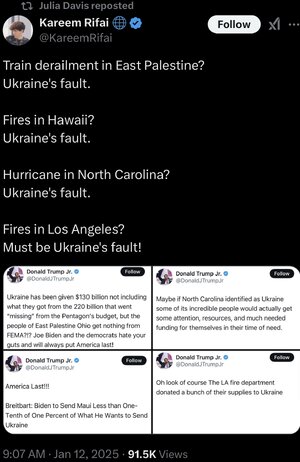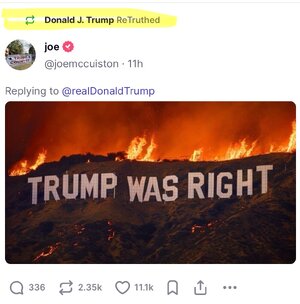- Messages
- 35,569
Navigation
Install the app
How to install the app on iOS
Follow along with the video below to see how to install our site as a web app on your home screen.
Note: This feature may not be available in some browsers.
More options
You are using an out of date browser. It may not display this or other websites correctly.
You should upgrade or use an alternative browser.
You should upgrade or use an alternative browser.
California Fires - Politics of Blame & Trump water claims
- Thread starter nycfan
- Start date
- Replies: 536
- Views: 18K
- Politics
- Messages
- 35,569
From WSJ story above:
“… On Thursday, a new unexpected foe cropped up: Alex Jones, among the world’s most notorious conspiracy theorists, was posting on X that L.A. firefighters were battling the blazes using ladies’ handbags as buckets because officials had donated equipment to Ukraine. The post has been viewed 29 million times.
Scott, the LAFD public-information officer, quickly explained publicly that the “handbags,” were actually canvas bags routinely carried by firefighters to douse small fires, because that is easier and faster than hauling out and connecting hoses.
“We’re trying to battle the most devastating natural disaster in Los Angeles history,” Scott said by phone on Saturday while driving to base camp on the fifth day of the wildfire ordeal. “It takes people and time to track down or debunk social media rumors—it takes us away from doing more important things.”
… Numerous falsehoods about Hurricane Helene surfaced online last September amid rising floodwaters in western North Carolina and in the aftermath.
“Bar none, this was probably the worst I’ve ever seen as far as misinformation and disinformation goes,” said Brian Haines, who helped manage the state’s joint information center.
In response, the North Carolina Department of Public Safety created a still-live “Ground Truth” webpage, and “Hurricane Helene FAQs” that plainly lists and rebuffs the many assertions ricocheting around social media.
Recovery efforts weren’t in fact “a land grab by the State of North Carolina” in disguise, nor were there “morgue trailers hidden with bodies still inside them.” It also wasn’t true, the state assured the public, that impacts from Helene were “due to weather manipulation.”
Officials decided this needed saying: “No technology exists that can create, destroy, modify, strengthen or steer hurricanes in any way, shape or form,” says the government website:
“The best we can do is provide [the public] with the most accurate information we have. Does everybody trust the government? No. We recognize this,” Haines said. “If you don’t steer the narrative to the truth, the lies will take over.” …”
“… On Thursday, a new unexpected foe cropped up: Alex Jones, among the world’s most notorious conspiracy theorists, was posting on X that L.A. firefighters were battling the blazes using ladies’ handbags as buckets because officials had donated equipment to Ukraine. The post has been viewed 29 million times.
Scott, the LAFD public-information officer, quickly explained publicly that the “handbags,” were actually canvas bags routinely carried by firefighters to douse small fires, because that is easier and faster than hauling out and connecting hoses.
“We’re trying to battle the most devastating natural disaster in Los Angeles history,” Scott said by phone on Saturday while driving to base camp on the fifth day of the wildfire ordeal. “It takes people and time to track down or debunk social media rumors—it takes us away from doing more important things.”
… Numerous falsehoods about Hurricane Helene surfaced online last September amid rising floodwaters in western North Carolina and in the aftermath.
“Bar none, this was probably the worst I’ve ever seen as far as misinformation and disinformation goes,” said Brian Haines, who helped manage the state’s joint information center.
In response, the North Carolina Department of Public Safety created a still-live “Ground Truth” webpage, and “Hurricane Helene FAQs” that plainly lists and rebuffs the many assertions ricocheting around social media.
Recovery efforts weren’t in fact “a land grab by the State of North Carolina” in disguise, nor were there “morgue trailers hidden with bodies still inside them.” It also wasn’t true, the state assured the public, that impacts from Helene were “due to weather manipulation.”
Officials decided this needed saying: “No technology exists that can create, destroy, modify, strengthen or steer hurricanes in any way, shape or form,” says the government website:
“The best we can do is provide [the public] with the most accurate information we have. Does everybody trust the government? No. We recognize this,” Haines said. “If you don’t steer the narrative to the truth, the lies will take over.” …”
- Messages
- 35,569
This has been widely mis-reported by “citizen journalists” as California requiring emissions tests before allowing the trucks through
——
True story: I once handled the financing of a company that leases fire trucks. For cost saving reasons, the vehicle titles were held by the lender rather than taking the time and expense of filing liens on title in states all over the country (I would like to add that was NOT what I recommended). One day I got an urgent call that half a dozen of those vehicles were trying to cross the border into Canada to help with wildfire relief and could not cross without their original title. I arranged for copies to be faxed to a border agent (this was a long time ago) and the originals to be sent via FedEx. The border officials still wouldn’t let the trucks cross without their original title — we finally got someone in a U.S. Embassy to call the right people to let the trucks and fire crews pas that night, before title arrived. Took months to get the titles back from the bastard who was being ridiculous about it in the first place.
- Messages
- 7,903
Each line is a record/data point. You will notice that the number of blue records is drastically decreasing to the right of the chart. Meaning that we are seeing more and more averages above the average.So do all those blue lines mean the average has been dropping?
sringwal
Iconic Member
- Messages
- 2,043
How did you arrive at that interpretation?So do all those blue lines mean the average has been dropping?
- Messages
- 1,147
lmmfao
sheep from both sides believe whatever they want to believe. whatever makes them feel warm, cozy and right. truth is nothing but a conditioned mindset
ZenMode
Legend of ZZL
- Messages
- 5,806
I guess the question is whether or not there are any state-wide policies/practices that actually did contribute to the fire, the likelihood of the fire being larger than it needed to be or restricted firefighters from fighting it effectively.
California prioritizes environmental protection more than many, if not most, states, I'd guess. For example, Newsom has apparently vowed to not let rebuilding be slowed by California's rather cumbersome environmental requirements for construction.
Are there similar practices/policies that contributed the carnage we're seeing now?
California prioritizes environmental protection more than many, if not most, states, I'd guess. For example, Newsom has apparently vowed to not let rebuilding be slowed by California's rather cumbersome environmental requirements for construction.
Are there similar practices/policies that contributed the carnage we're seeing now?
I guess the question is whether or not there are any state-wide policies/practices that actually did contribute to the fire, the likelihood of the fire being larger than it needed to be or restricted firefighters from fighting it effectively.
...
Are there similar practices/policies that contributed the carnage we're seeing now?
In time, I will be interested in see how LA and CA approach two issues.
The first issue is zoning. LA is majority-zoned for single homes. That affects affordability, its transportation infrastructure and explains in part why there is so much development in areas prone to wildfire. That won't change when Altadena and the Palisades are rebuilt - placing multi-home dwellings in fire-prone areas is an even worse idea - but I will be interested in seeing if this affects zoning policy overall in the region. Given what's happening elsewhere, I doubt anything will change.
The other issue is how to suppress wildfires when you don't have access to aircraft in high winds. This will require additional storage reservoirs, high pressure improvements to deliver water sufficiently at high elevations and on-ground fire suppression systems. My guess is that this will costs hundreds of billions to create satisfactory capability across the region. Will they do this? Given the events of the past week, I think they have to.
lawtig02
Legend of ZZL
- Messages
- 5,547
As long as the same general standard is applied to both California and Florida, I think these discussions can be very worthwhile. Both states are relatively wealthy. Both are coastal. Both are prone to natural disasters. Both are having major issues with developable land for the population that wants to live there, and both are really struggling with soaring property insurance premiums. Both are very much impacted by climate change. The only difference, as it relates to this issue, is that one is governed by conservatives and one is governed by liberals.In time, I will be interested in see how LA and CA approach two issues.
The first issue is zoning. LA is majority-zoned for single homes. That affects affordability, its transportation infrastructure and explains in part why there is so much development in areas prone to wildfire. That won't change when Altadena and the Palisades are rebuilt - placing multi-home dwellings in fire-prone areas is an even worse idea - but I will be interested in seeing if this affects zoning policy overall in the region. Given what's happening elsewhere, I doubt anything will change.
The other issue is how to suppress wildfires when you don't have access to aircraft in high winds. This will require additional storage reservoirs, high pressure improvements to deliver water sufficiently at high elevations and on-ground fire suppression systems. My guess is that this will costs hundreds of billions to create satisfactory capability across the region. Will they do this? Given the events of the past week, I think they have to.
These are important discussions to have. The cost of responding to these disasters is enormous, and it's only going to increase. So let's have the discussions in as honest, transparent, and critical a way as we can. But if someone critiques California without critiquing Florida, or vice versa, they can just fuck right off from my perspective. These are issues that should not be political, and I'm happy to ignore anyone who wants to make them such.
My sense is that Florida is much closer to the ecological abyss than SoCal is. The insurance market is already starting to enforce rationality there, and it's not pretty. From a policy perspective, the next fight is whether or to what degree he federal government agrees to be the insurer of last resort. IMO, that's an entitlement that both liberals and conservatives should be fighting against.
ZenMode
Legend of ZZL
- Messages
- 5,806
But if someone critiques California without critiquing Florida, or vice versa, they can just fuck right off from my perspective. These are issues that should not be political, and I'm happy to ignore anyone who wants to make them such.

I think there's two parts to this: prevention and how to address what can't be prevented. There are things that can be controlled by Florida, California and I'd probably include Tornado Alley and there are things that can't be controlled. We can't control tornadoes or hurricanes and the fact that fires are going to happen, but things can be done to lessen the impact of those events. Houses can be built to be hurricane-proof. The ground in forest areas can be maintained. Stuff like that.
lawtig02
Legend of ZZL
- Messages
- 5,547
??? That has nothing to do with my comment.
I think there's two parts to this: prevention and how to address what can't be prevented. There are things that can be controlled by Florida, California and I'd probably include Tornado Alley and there are things that can't be controlled. We can't control tornadoes or hurricanes and the fact that fires are going to happen, but things can be done to lessen the impact of those events. Houses can be built to be hurricane-proof. The ground in forest areas can be maintained. Stuff like that.
- Messages
- 3,801
Or you could just speculate in accordance with your preconceived political notions.Are there similar practices/policies that contributed the carnage we're seeing now?
ZenMode
Legend of ZZL
- Messages
- 5,806
My indirect point was that there probably isn't much in Florida to critique, that I know of. They can't prevent hurricanes. They can maybe take steps to flood-proof in some way. Am I missing something???? That has nothing to do with my comment.
ZenMode
Legend of ZZL
- Messages
- 5,806
I don't think all of my preconceived political notions are baseless. It's not a stretch to recognize the differences, politically, between Florida and California. To my knowledge, Florida has never put legal restrictions on insurance companies ability to manage rates as was the case with Prop 103 in CA.Or you could just speculate in accordance with your preconceived political notions.
lawtig02
Legend of ZZL
- Messages
- 5,547
Yes. Everything that can -- and should -- be critiqued in California can -- and should -- be critiqued in Florida. This seems obvious to me, but are you not seeing it somehow?My indirect point was that there probably isn't much in Florida to critique, that I know of. They can't prevent hurricanes. They can maybe take steps to flood-proof in some way. Am I missing something?
Share:


